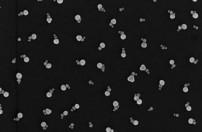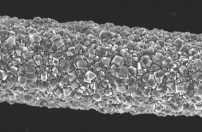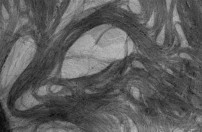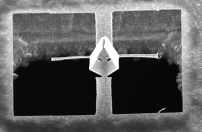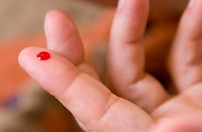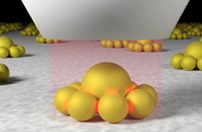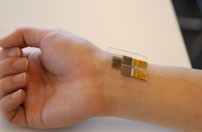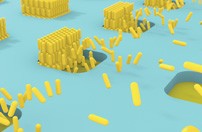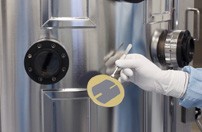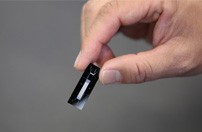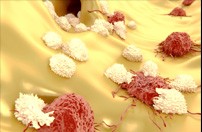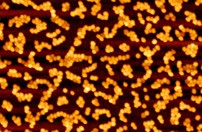Biosensors
Current
Automatically assembling nanolenses
A team of researchers has created a scalable production method for a class of nanoscale lenses using the electrostatic forces between charged nanoparticles, enabling wider application of the technology.
Read more...Diamond coating Carbon Fibre
A team of Victorian scientists have coated carbon fibre with diamond, enhancing the material’s usability in medical and sensor applications where the composite material offers huge potential advantages.
Read more...Exploring gold nanowires and nanorods
Professor Wenlong Cheng from Monash University has been exploring unique properties of gold nanomaterials for over 16 years. Two recent projects, conducted at ANFF-Vic’s Melbourne Centre for Nanofabrication (MCN), involved gold nanorods and gold nanowires.
Read more...Folding plasmene nanosheets
Professor Wenlong Cheng has been investigating how to make an unusual class of materials with exotic properties and unprecedented real-world applications.
Read more...Next generation pathogen detection with lab-on-a-chip platforms
Detection of pathogens is critical for disease diagnosis, food safety control, water quality monitoring and homeland security. Traditional detection methods are time consuming and complex – a portable lab on a chip enables fast and simple pathogen detection.
Read more...Nano-flowers for biosensing
Gold nanostructures separated by a small gaps show a strong focusing effect of the electric field into this gap when exposed to light. Using surface enhanced raman spectroscopy, these structures have the potential to detect minute quantities of molecules used in explosives or cancer markers in blood.
Read more...Electronic skins – the future for medical devices
Technologies are increasingly becoming smaller, lighter and smarter, and now they are flexible and wearable too. Current rigid circuit board technologies are limited in their applications, particularly in regards to medical devices and bionics. Here, we look at wearable heart rate and blood pressure sensors.
Read more...Black silicon sensors for molecular contamination
Black silicon provides a unique platform for a non-reflecting, all-direction-absorbing surface, which can be used for sensing and fingerprinting of molecular and microbial contamination. This is done by sensing the light scattered in air, water, food, body fluids by various compounds.
Read more...Ultra-thin optical sensors for the detection of toxic chemicals
Current chemical sensors pose a variety of inhibitors to their use such as cost, portability and reproduceability. Development of a new, ultra-thin, 2D optical material enables the rapid, sensitive and inexpensive detection of toxic chemicals in air, water and soil.
Read more...Archive
Self-assembling gold nanorods show huge potential
Nanostructures fabricated with metal nanoparticles hold great promise for applications in biosensing, optical analysis, computing and solar energy conversion. One approach looks at programming the spontaneous self-assembly of nanoparticles into the desired architecture.
Read more...Safeguarding water against oil spills and polution
Oil spillage, organic solvents and other industry contaminants are primary pollutants of water sources around the globe. The existing conventional methods used to solve spillages are not very efficient and have their own environmental consequences. New nanomaterials and nanotechnology are aiding the development of new high-efficient absorption materials.
Read more...Industry R&D looks at water source analysis
Through the Small Technologies Industry Uptake Program (STIUP), MCN has assisted a Melbourne based water management company to develop an automated water sensor production process to commercialise pollutant analysis sensors.
Read more...Identifying key materials for chemical sensors
Researchers from CSIRO have been working with MCN to develop a rapid, convenient and effective solution for discovering multicompositional materials useful in the development of chemical sensors.
Read more...50nm biosensors to detect antigens
Through using EBL to develop a set of processes to fabricate biological nanosensors, researchers at MCN and the University of Melbourne have developed a nanosensor that is sensitive to a specific type of biological antigen.
Read more...Rapid point of care sensor for infectious disease discrimination
Together with Biodetectors Pty Ltd, MCN is working on the rapid point of care sensor for infectious disease discrimination. This technology is useful in the fields of genetic screening, diagnostics, drug delivery and protein analysis.
Read more...Cantilever-based biosensors to help detect cancer antibodies
Utilising a photoactive material, researchers at MCN and Deakin University are designing a cantilever-based biosensor which detects cancer biomarker antibodies.
Read more...Enhancing sensing applications
In sensing applications, it is necessary to create strong light field enhancement on a nanoscale. The challenge is to increase the light field enhancement, which is limited by the “sharpness” of the edges and corners of nanoparticles and is linked to fabrication resolution.
Read more...Detecting chemicals and biological contaminants
As different chemicals interact with light in different ways, researchers from CSIRO are developing new ways of detecting chemicals and biological contaminants, using light to detect and identify the different chemicals and biological substances.
Read more...Environmental monitoring with nanobio membranes
Researchers from Monash University are developing intelligent, ultra-thin nano-biomembranes for applications in environmental monitoring. This work will lead to improved technologies in sea water desalination, for example.
Read more...Bottom up methods for nano building blocks
A lack of suitable bottom-up fabrication methods which allow for the assembly of custom-defined nanostructures impedes the integration of a plethora of new nanoparticulate building blocks into everyday devices in applications such as electronics, optoelectronics, sensing and photovoltaics.
Read more...Vertical arrays of gold nanorods achieved
Fabrication of novel self-assembling metallic nanostructures shows great potential for applications in biosensing, optical analysis, computing and solar energy conversion.
Read more...Manipulating hot spots to increase biosensor sensitivity
Through the characterisation of gold nanoparticle surface assemblies and the manipulation of their electric field hot spots, researchers at MCN and Monash University are looking to increase the sensitivity of biosensors.
Read more...
